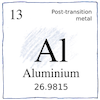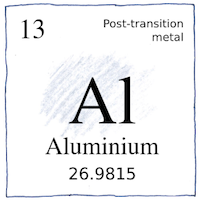Copenhagen, Berlin—Hans Christian Ørsted,
Friedrich Wöhler
elements

|
Aluminium
Some sources say Ørsted isolated aluminium. Others say he failed. Some sources say Wöhler showed Ørsted’s method didn’t work. Others say Wöhler didn’t know how to make it work. At any rate, one or both of them isolated aluminium by reacting anhydrous aluminium chloride with potassium amalgam.
Atomic number 13
Light and bright common as clay, rare as ruby used in many alloys for the statue of the Anteros in Piccadilly Circus the capstone of the Washington Monument and the Austin “A40 Sports” delivers beer in cans wraps casseroles in foil swallowed as antacid tablets
History of the name
Humphry Davy named it alumium after alum, which is aluminium sulfate or hydrated potassium aluminium sulfate. Davy’s idea was to use the -ium suffix for metals, like silicium and glucium, because he thought alumium would turn out to be a metal. Someone, however, convinced Davy to go with aluminum, which became accepted in the United States. The International Union of Pure and Applied Chemistry, however, added back the -ium suffix, resulting in aluminium.



As an citizen of the United States, I am likely to call this element “aluminum.” This spelling is printed on my box of Reynolds Wrap. Therefore, “aluminium” seems affected.
Before the introduction of the Hall-Héroult process in 1888, aluminium was more rare than silver. In 1884, the pyramidal aluminum apex for the Washington Monument was the largest piece of alumminum ever cast, at 100 ounces.
See also in The book of science:
Readings in wikipedia:
Other readings: